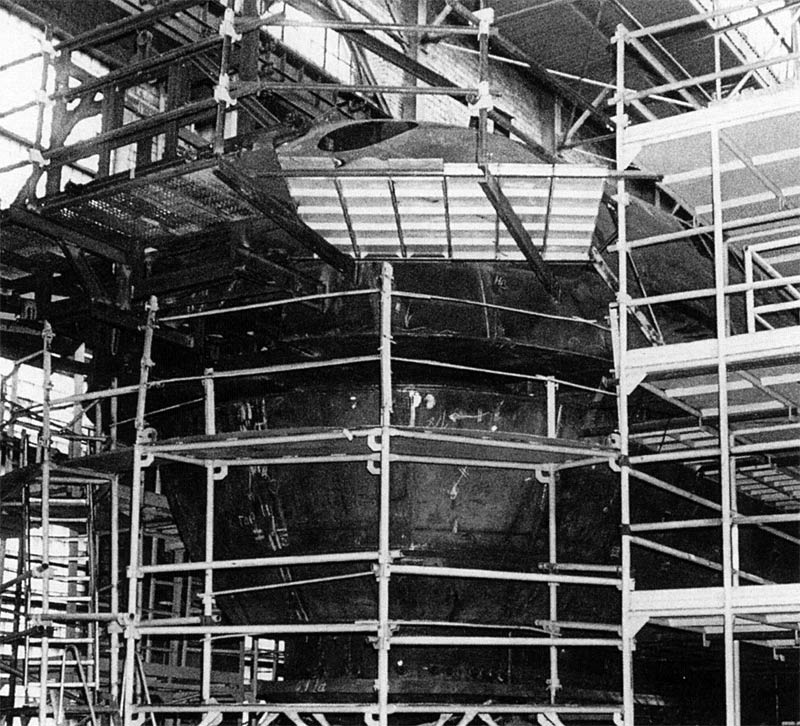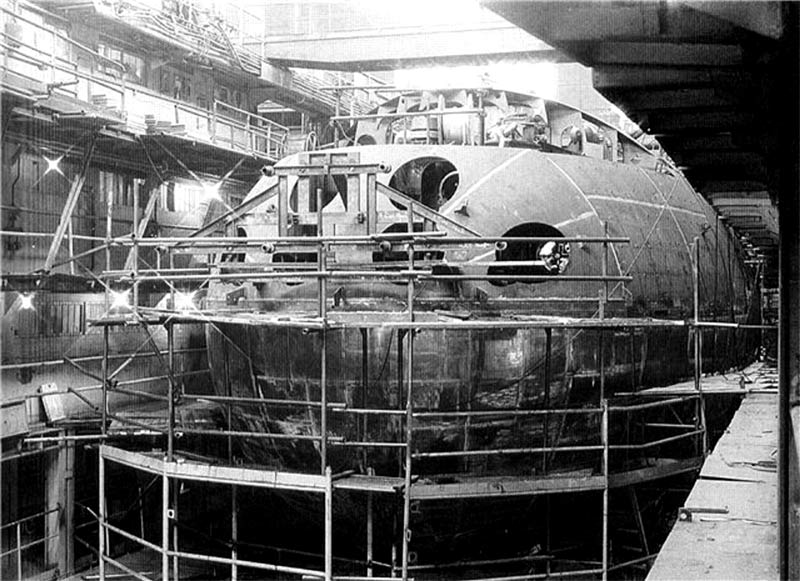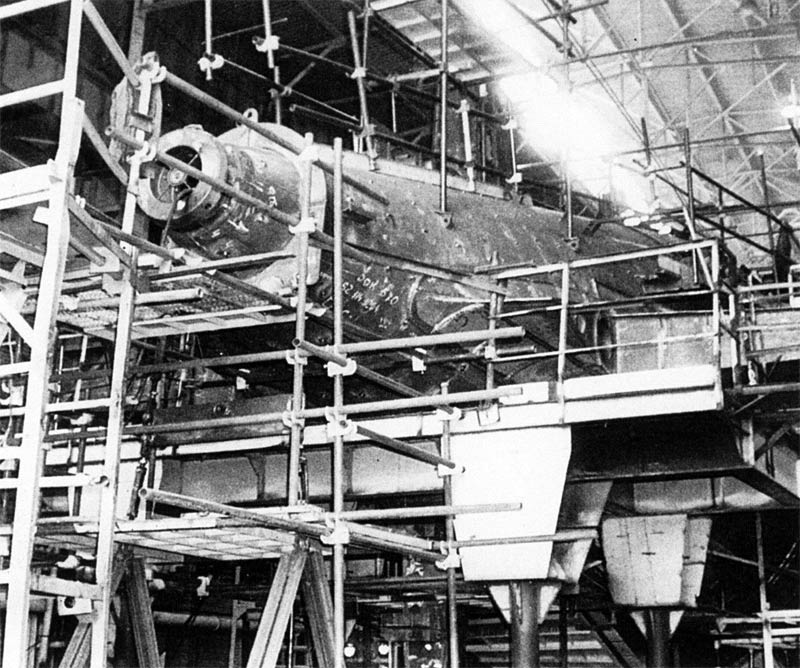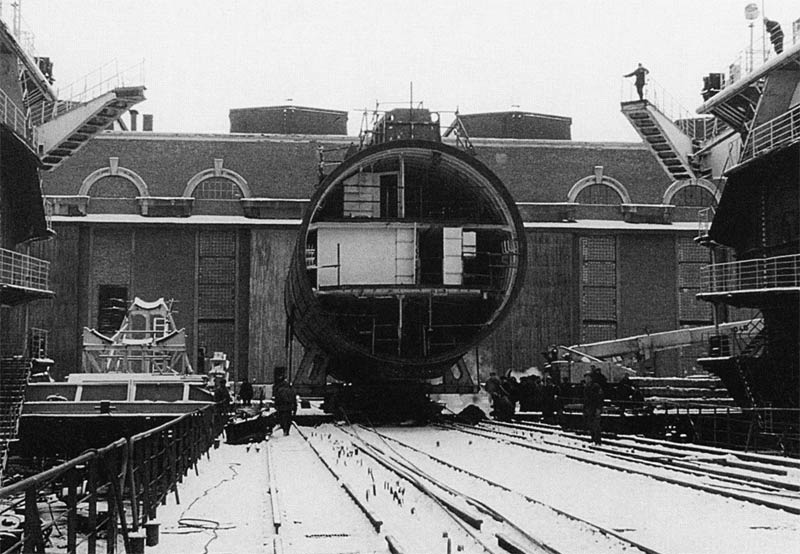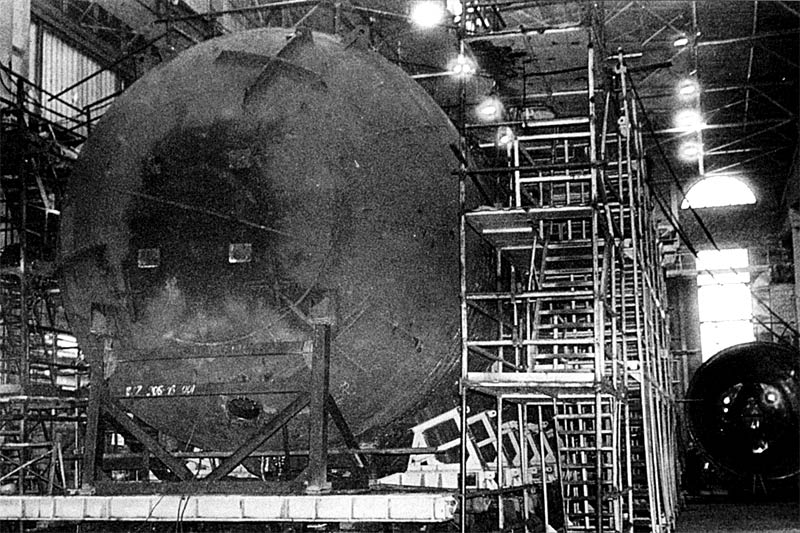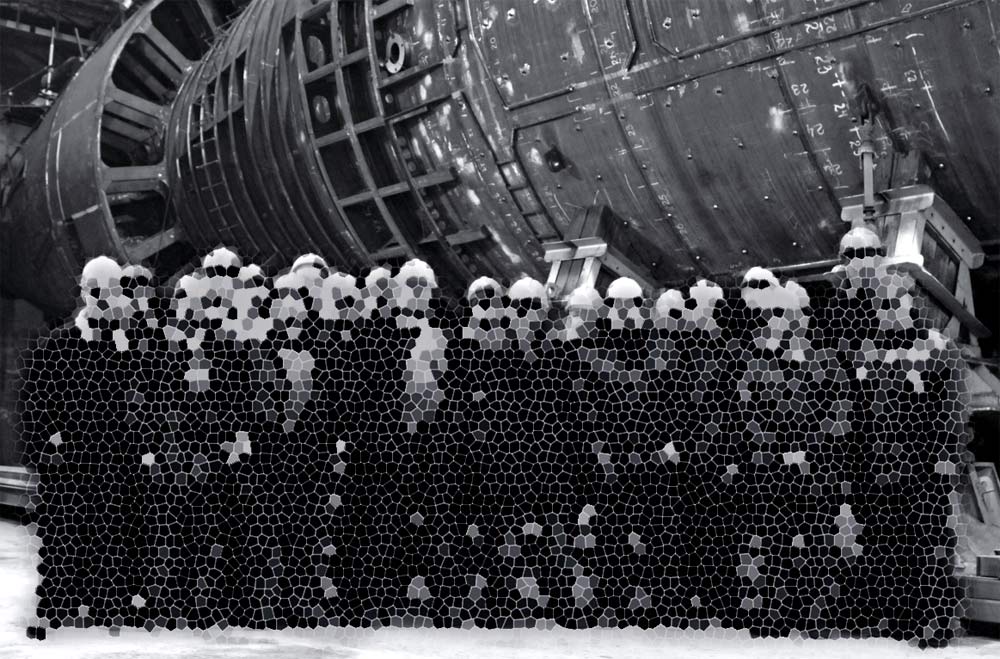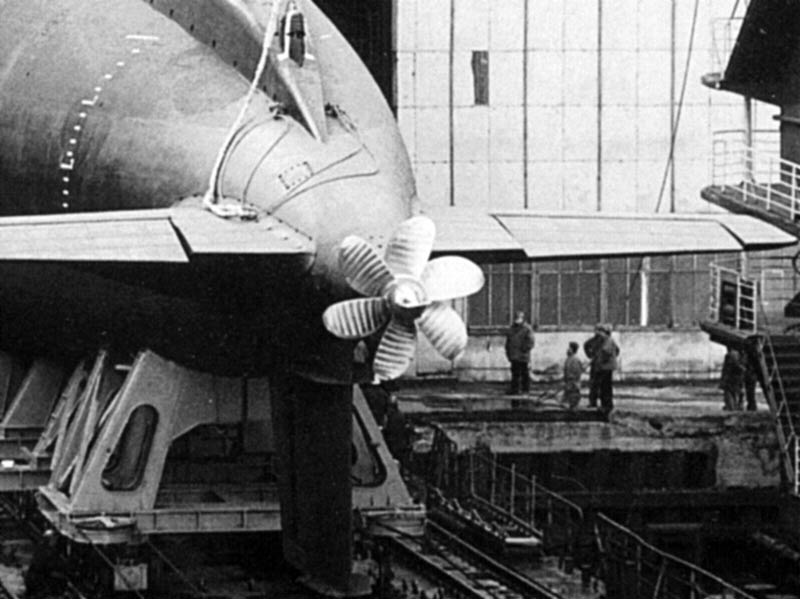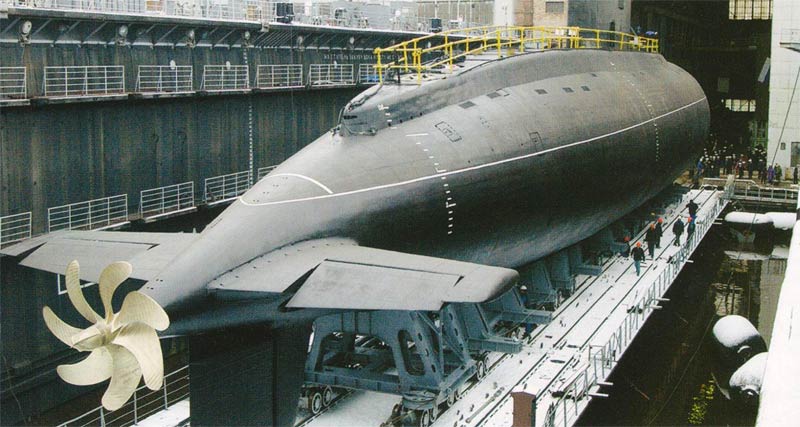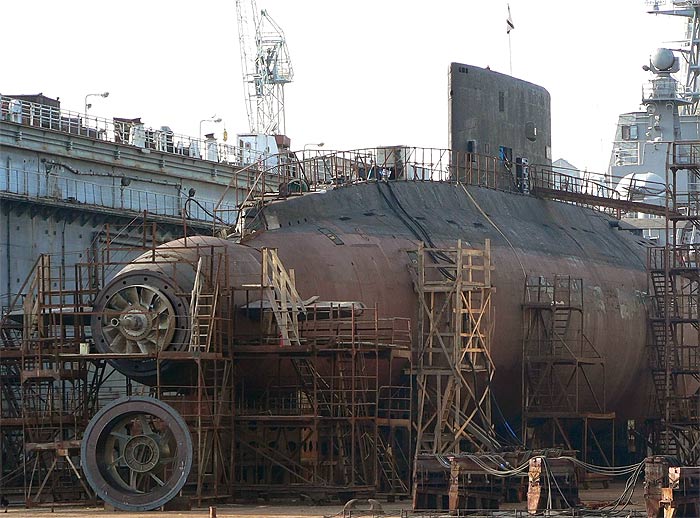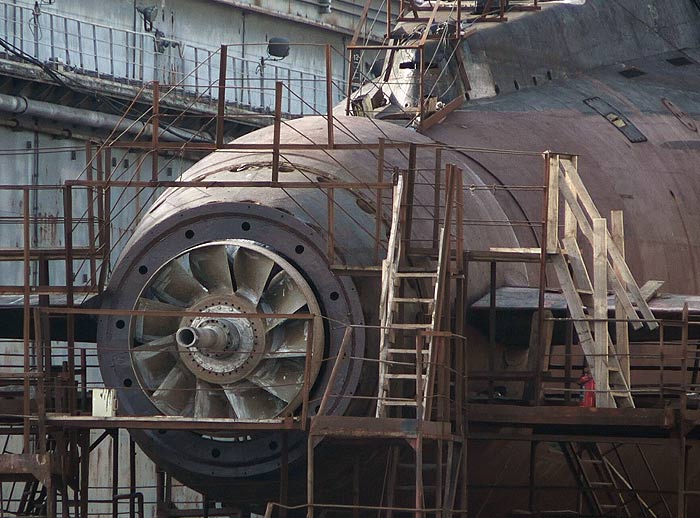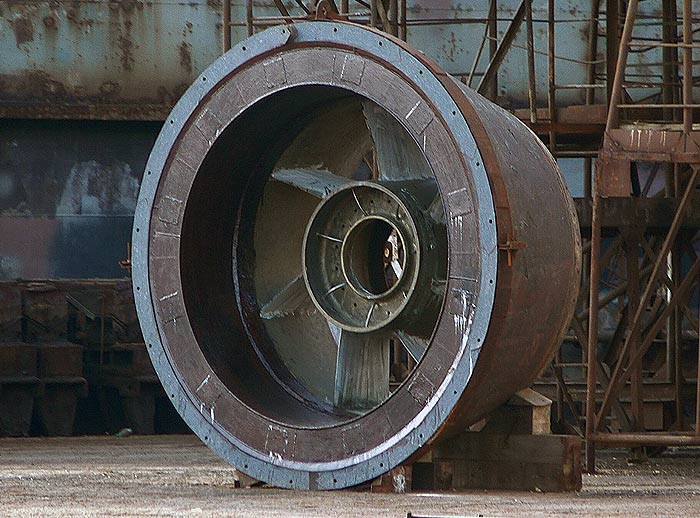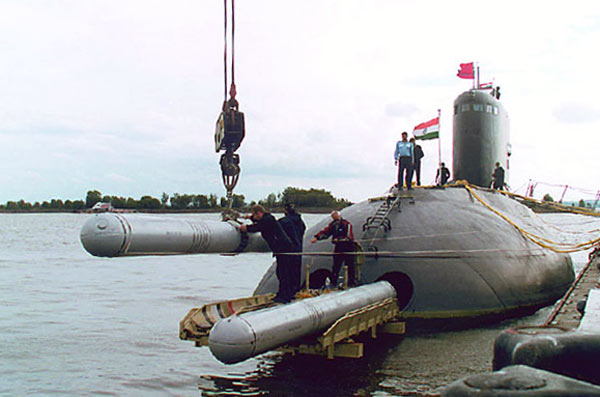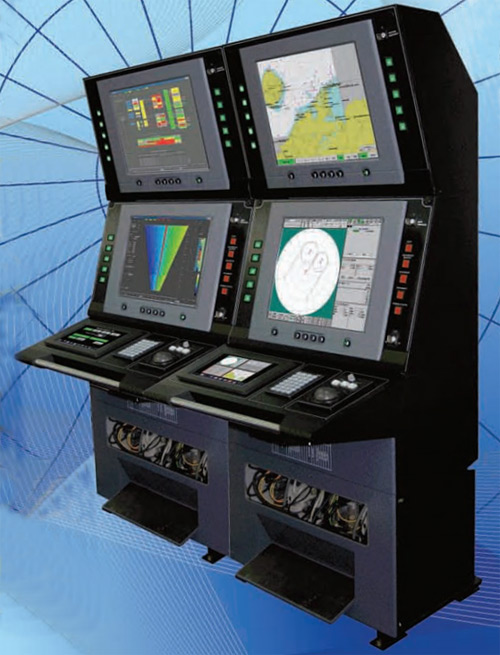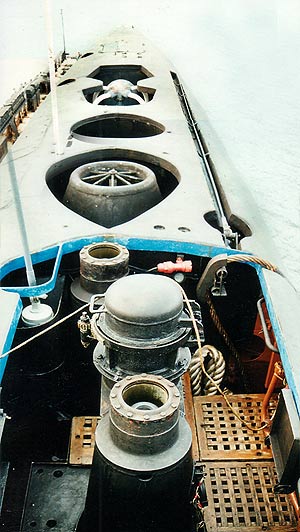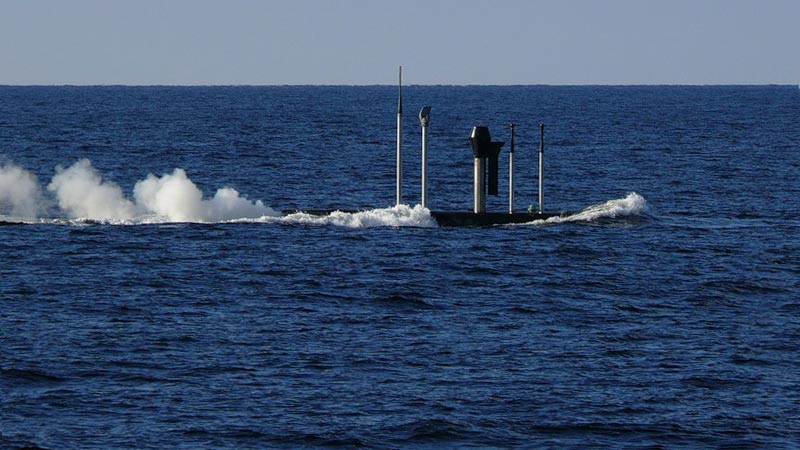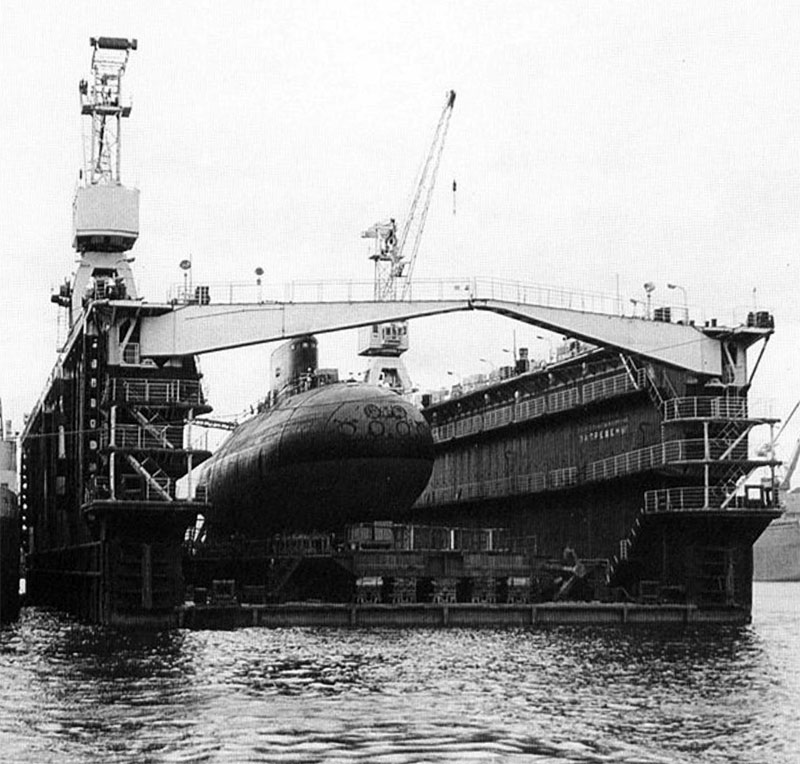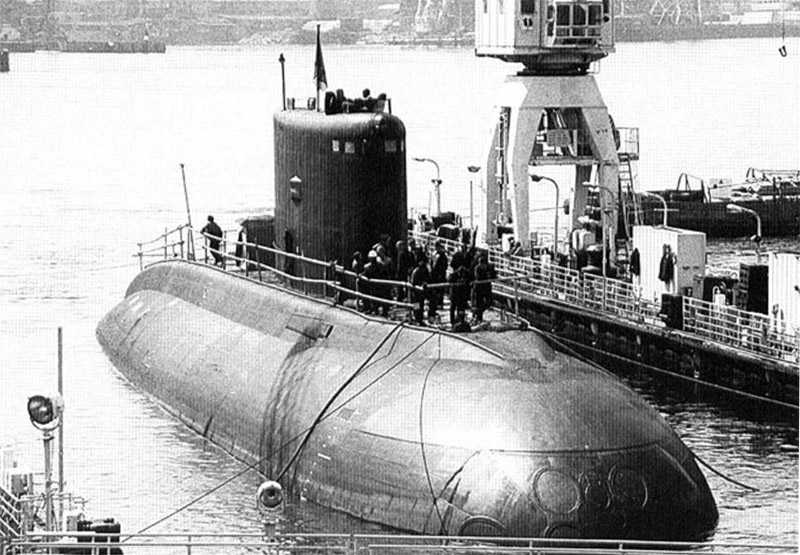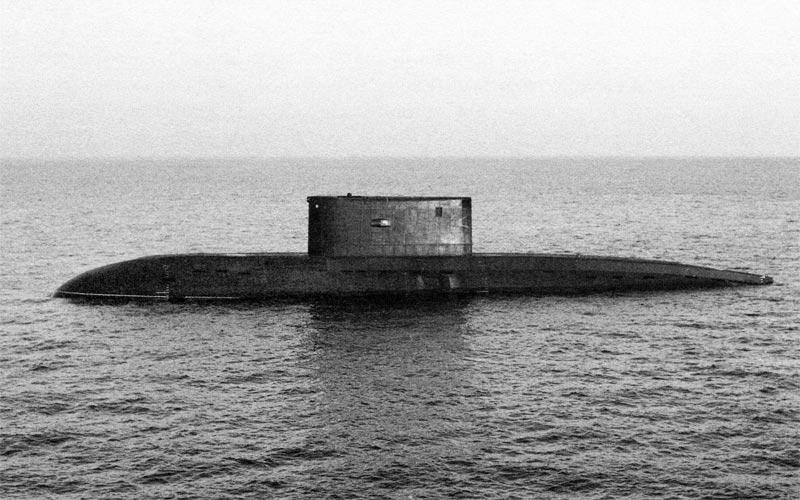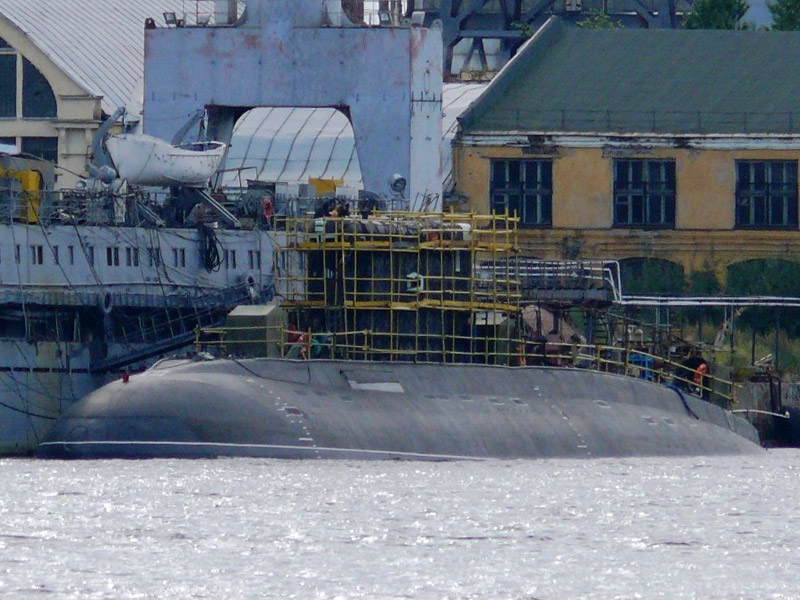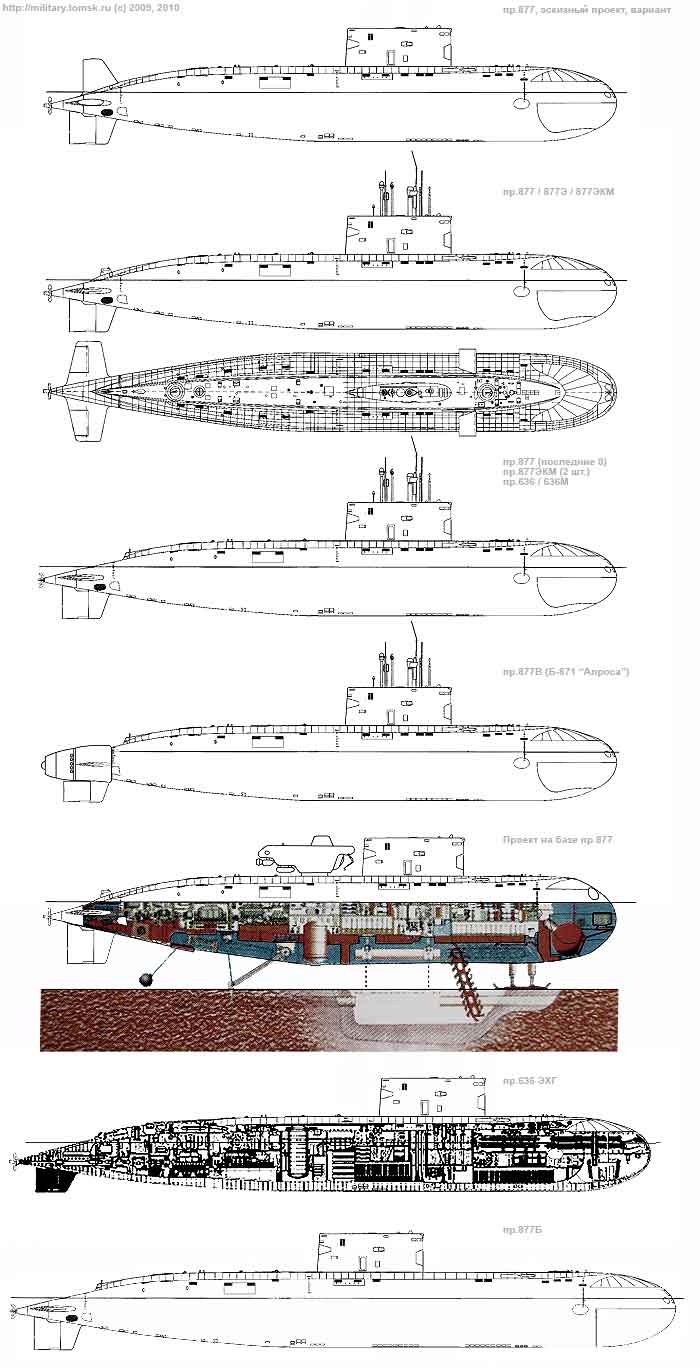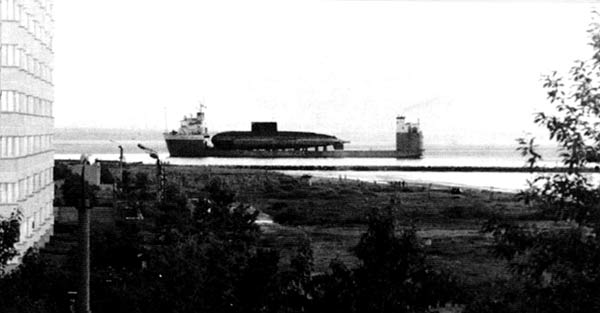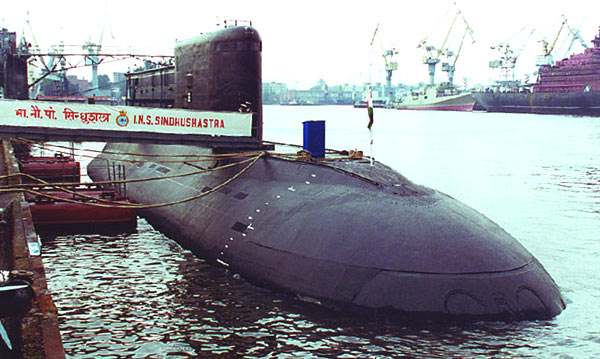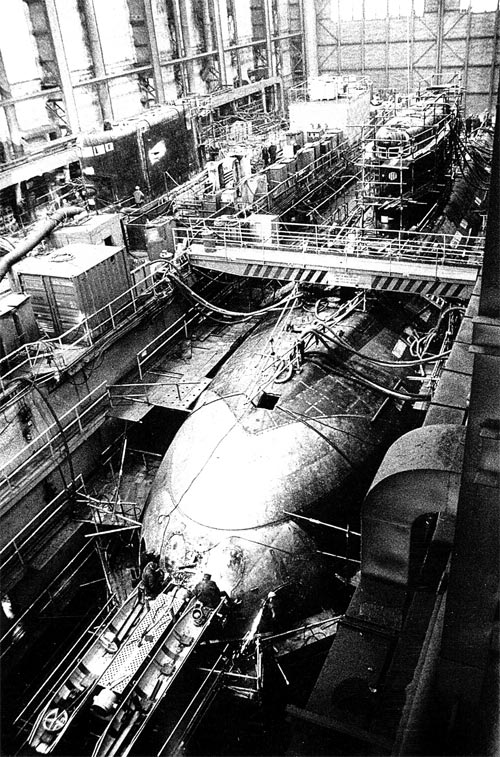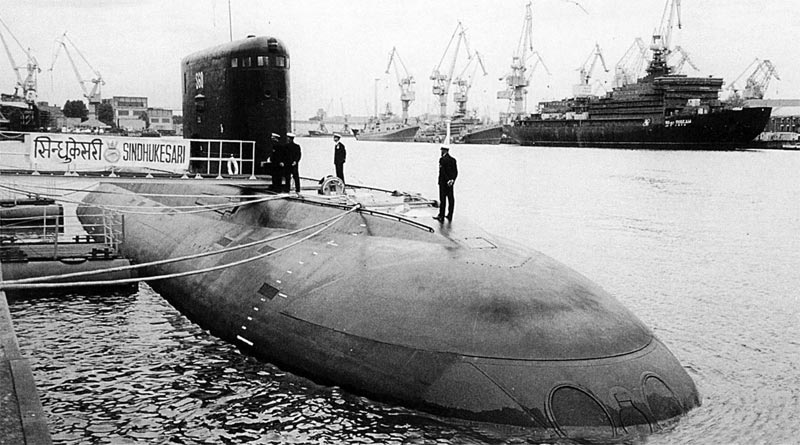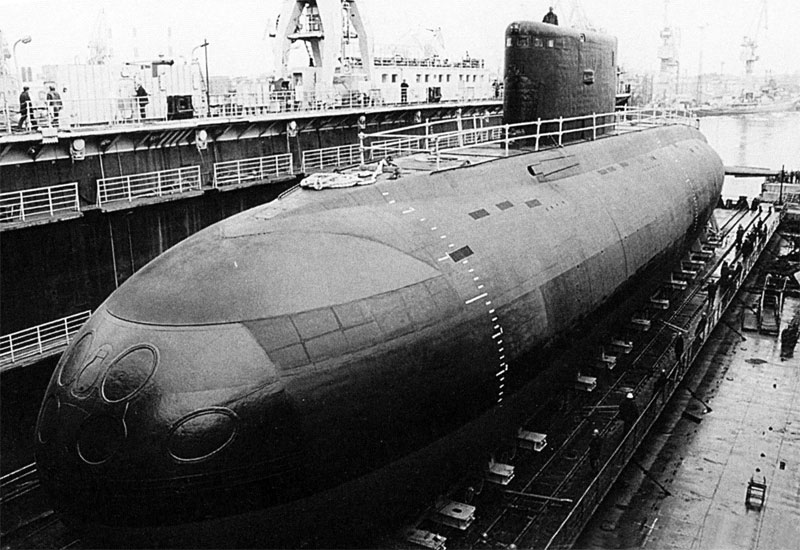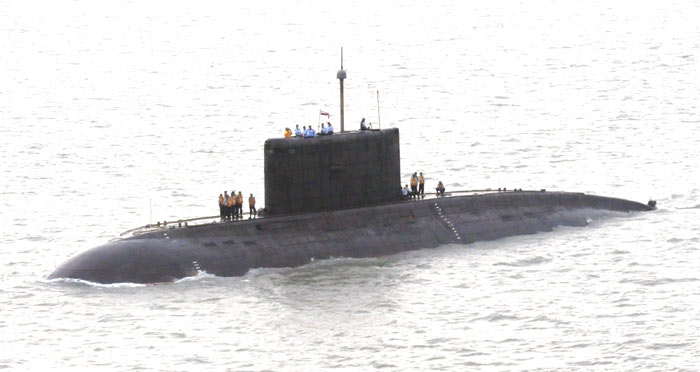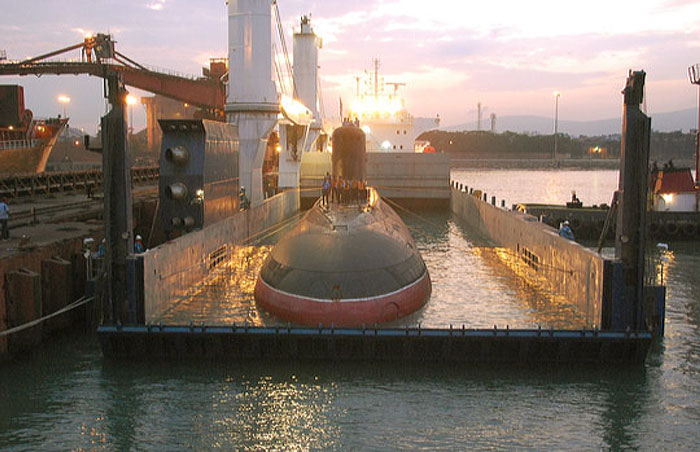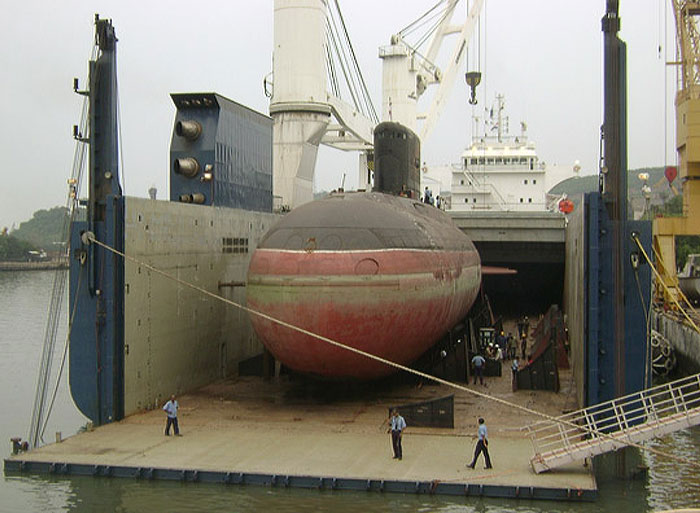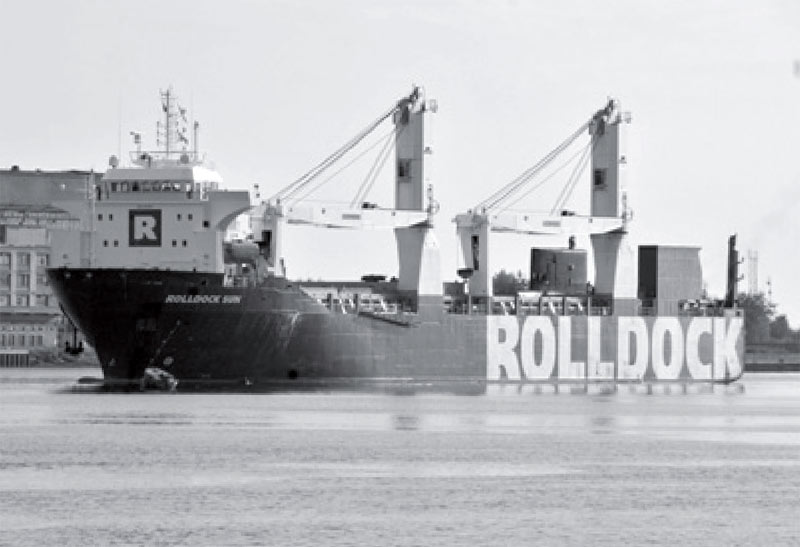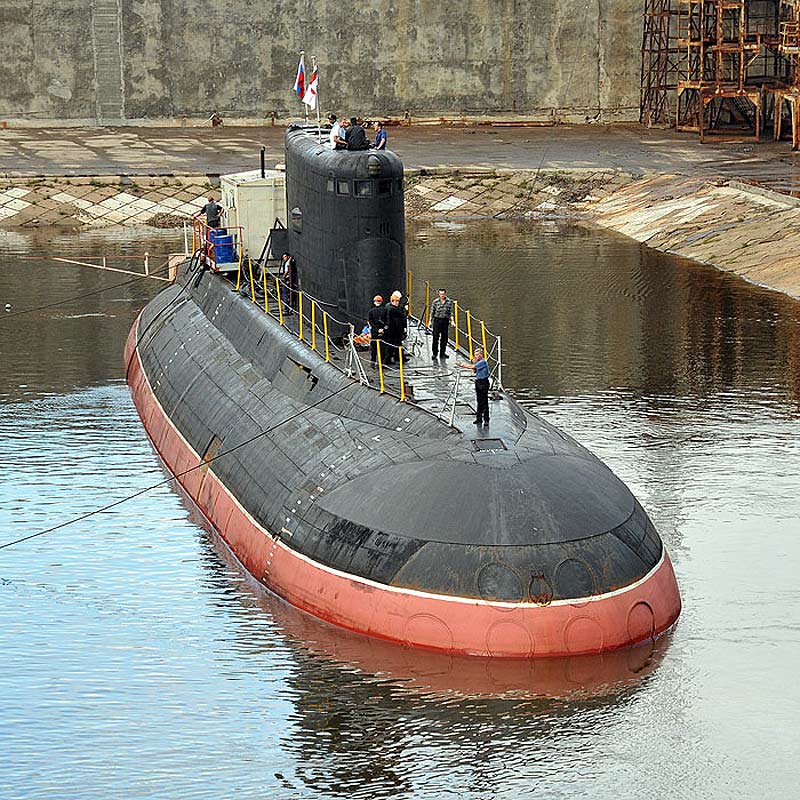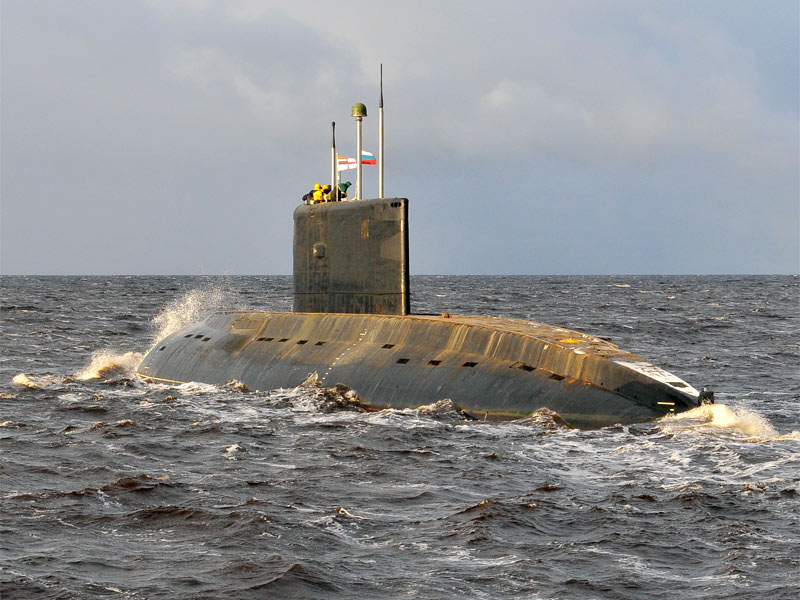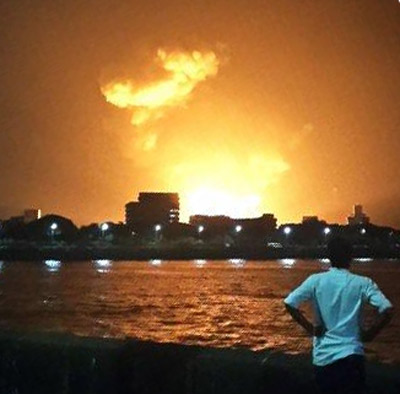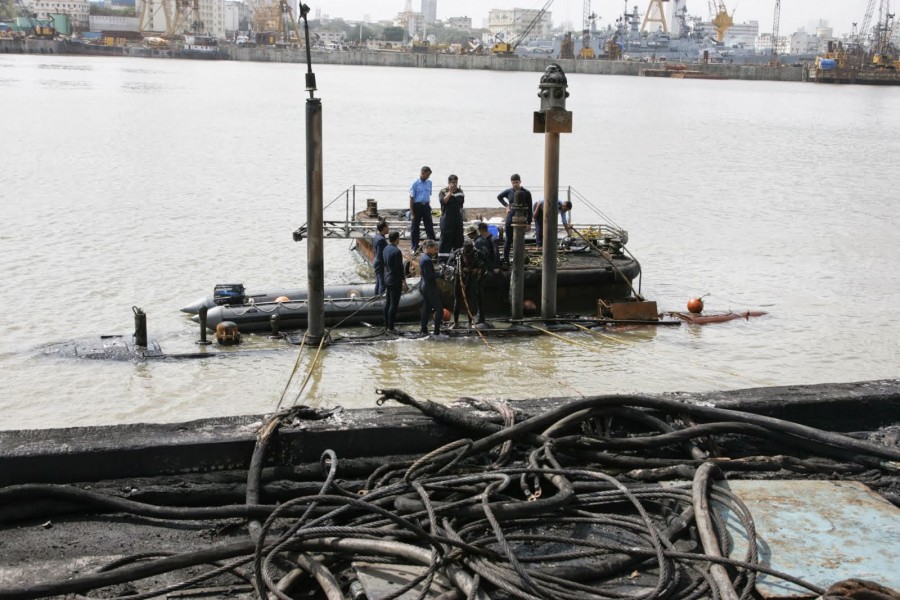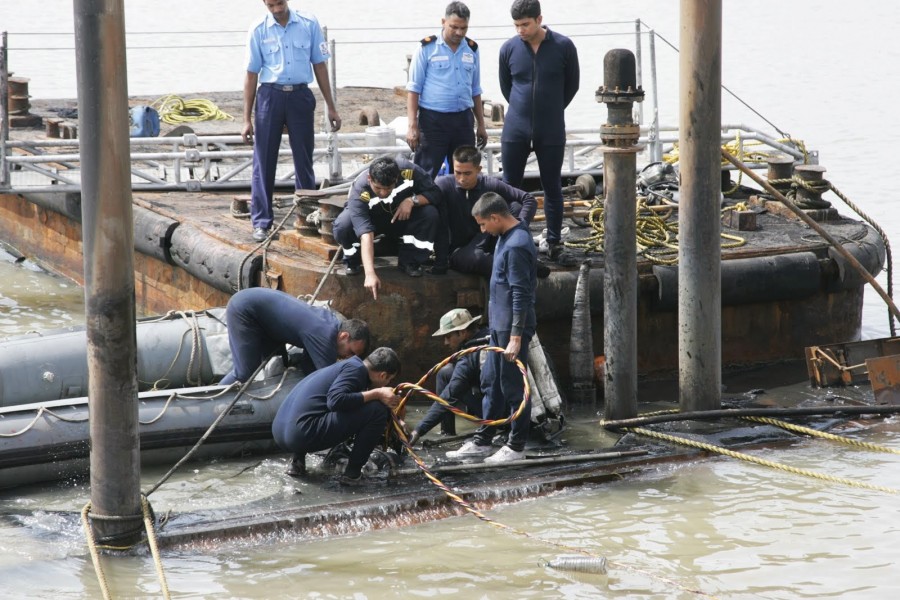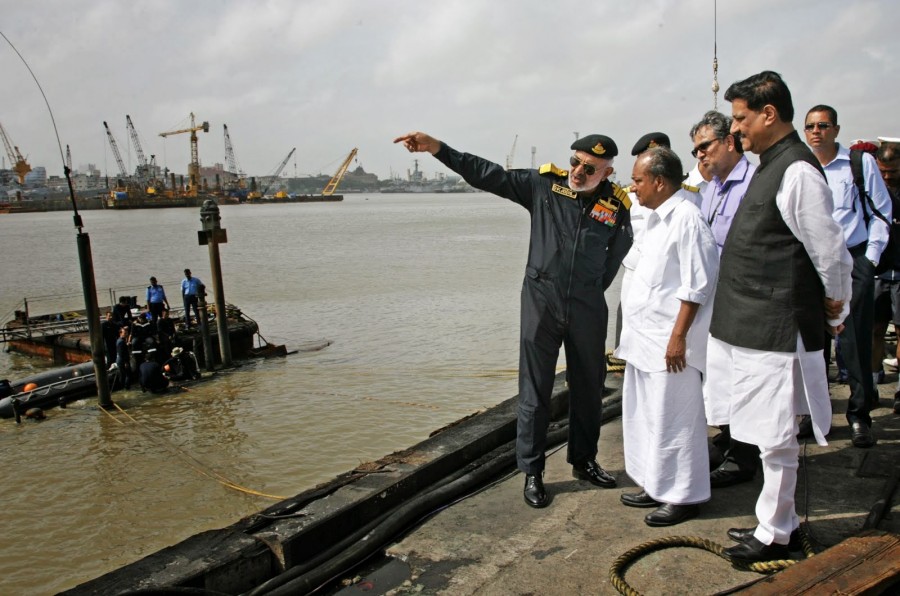Anti-ship cruise missile. Develop a set of NGOs launched "Engineering" (formerly - OKB-52) Chelomei (since 1984 Chief Designer - G.A.Efremov) of the Decree of the USSR on May 17, 1979 Rocket is a further development of the missile complex P-500 starting with the preservation of equipment and a marked increase in the range of action through the use of a new starting of the engine, increasing the volume of fuel sustainer stage, reducing the weight of booking and other improvements.
The first test-fired from the ground stand SM-49 Nenoksa - December 3, 1982 ( 10 hours 55 minutes) - start failure - starting block is not separated from the rocket, the rocket broke apart and fell by 8 flight. The second launch - April 9, 1983 - the same result by 9 seconds of flight. As a result of analysis of failed tests found that the failures were the fault of the control system of the rocket. The third start was successful (probably in June 1983). Tests with SSGN pr.675MKV launched December 22, 1983 Joint testing of the complex P-1000 and SSGN pr.675MKV - 1985, the first launch in joint trials - 2 missile salvo (two missiles hit the target in spite of the failure of the system maintain the pressure in the instrument compartment and operator error).
The second launch through joint tests - November 8, 1985 - trehraketny volley, one rocket was the failure of the radar sighting device (radar), two other rockets poryazili goal. As a result, aircraft design, and joint tests performed 18 launches of which 11 are found to be successful launches. Test management and test equipment completed in 1985. In December 1985 signed the act of completion of joint testing with the recommendation of the complex P-1000 "Vulcan" to the adoption with carrying out routine tests in 1986 to carry out routine tests allocated 8 rockets planned to spend 4 missile salvo and 4 single missile launch different programs.
One of the single starts (24 April 1986) was held with the starting rocket engine complex of P-500 on the program management of the complex missile P-500. Start was successful. 18 and 19 June 1986 held two successful start-up to check noise immunity missiles.Chetyrehraketny volley was held July 4, 1986 (three missiles equipped with telemetry equipment on the grounds that the equipment at the site could not receive information from 4 missiles). The rocket is not equipped with a telemetry system, lost control on the approach to the target, the cause has not been established. In 1986, the creators of the complex have been awarded the Prize of the USSR Lenenskoy (source ). Complex "Volcano" adopted by 18 December 1987 Series production of missiles complex "Volcano" was conducted on the "Arrow" in Orenburg. Rocket made from 1985 to 1992
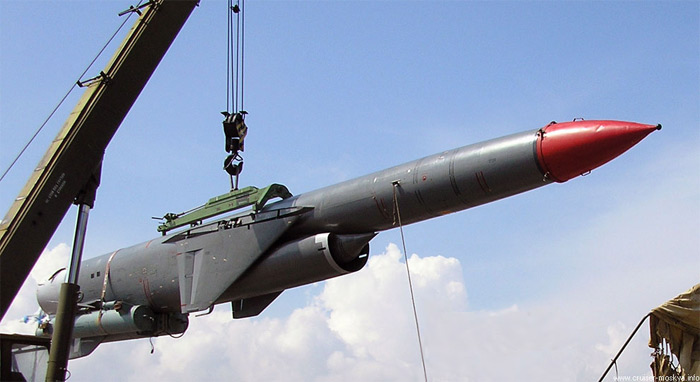
3M70 missile complex P-1000 "Volcano" ( http://www.cruiser-moskva.info ).

Start 3M70 missile complex P-1000 "Volcano" with conventional CDS ( http://www.npomash.ru ).
Launcher :
- ground launcher SM-49 - test missiles at the site Nenoksa;
- missile cruiser pr.1164 - probably Single container PU CM-248, similar complexes U-500
- SSGN pr.675MKV - probably similar to PU Single container complex P-500
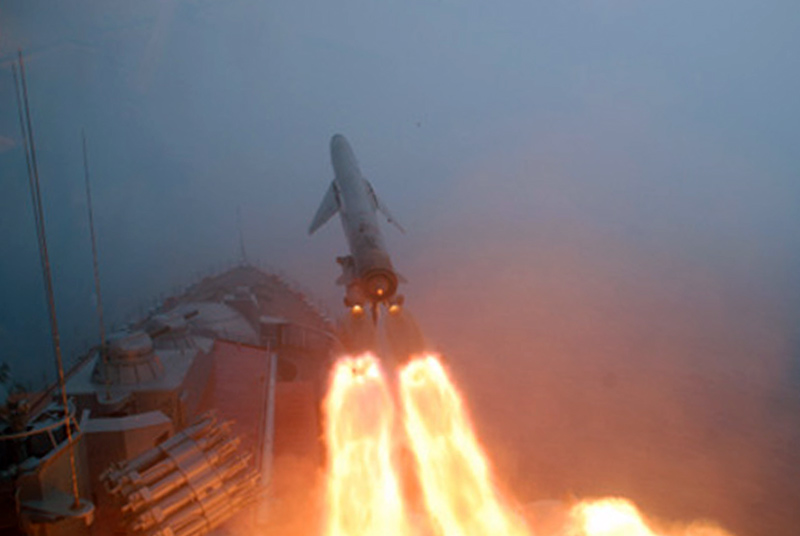

Start 3M70 missile complex P-1000 "Volcano" with pr.1164 missile cruiser "Moskva" ( http://www.npomash.ru , http://forums.airbase.ru ).
Control and guidance - inertial missile control with correction according to the radar homing - developed by the Central Research Institute "Granit", chief designer of the control system A.V.Chizhov, on-board radio-technical equipment - B.L.Godlinik, autopilot - AN Kuchin, FDC - V.A.Nikoltsev and E.A.Gorbachev. Breeding goals probably either automatically or by remote control principle (the operator of the ship according to radar missiles), or a combination. The rocket used made on the basis of a new element to the onboard computer autopilot A21 B9 (other than the missiles of F-500), which is coupled with a new starter motor and other (probably) control algorithm for the starting phase of the trajectory, which increased range. Significantly improved noise immunity radar seeker by improving on-board digital computer.
Ship and aircraft (placed on the rocket) appliances automated control system, as well as test equipment and control complex re-created. The control system launch, depending on the configuration starting the engine can be operated according to the program start-up and flight ASM P-500 "Basalt" or program " Volcano. " The missile guidance algorithms used by logic select the main goal in the order ships. After receiving the coordinates of the target, a missile with radar switched off (radio-locating visor) decreased by low altitude and to fly to the point of target coordinates. At the point of origin objectives include radar (radio-location finder), and selects and target acquisition. Analyze the size of the goals and objectives of the removal of the point target coordinates. Lift excess agloritm allows you to choose the biggest target in the order ships.
In order to overcome missile defense and air defense rocket provided protivozenitny maneuvering at low altitude and the dispersal of missiles in a salvo at the front (to be preceded by a gathering with a group of rockets) before turning on the radar at the final stage. The rocket is set Station setting jamming protection system 4B-89 "Bumblebee", developed since 1965 in the laboratory of the department №25 CRI "Granite" under the guidance and R.T.Tkacheva Yu.A.Romanova.
Instrument compartment on a rocket made airtight and equipped with sitemy maintain pressure (test starts for the shore stand in Nenoksa since March 25, 1984 Decree of the USSR in October 1987 instructed to carry out work to improve the accuracy of missiles of "Volcano" with working precision laser guidance channel and the creation of missiles "Volcano LK" . Work on the pulsed laser guidance channel conducted CRI "Granite" under the leadership of S.A.Sharova. system to recognize the geometric parameters of the target ship, and provide instructions on the correct trajectory of a missile to hit the most vulnerable sections of the target ship. System Tests were conducted in Sevastopol for passing ships and aircraft flying laboratory IL-18.
Development of laser guidance channel as a missile guidance systems started up in 1987 chief designer of onboard equipment missiles - V.G.Senkov, chief designer of the laser channel - S.N.Sharov. The launches of missiles equipped with homing serial laser channel planned for 1987-1989 gg Channel laser equipment was placed in the diffuser inlet. Technological missile for ground tests of the system has passed bench tests. On the test site in North Nenoksa it planned to make 5 missile launches from the ground stand (on dr.dannym test allocated 9 missiles). But probably in 1988-1989, the development of the theme of "Volcano LC" was discontinued. The beam diameter - ok.10 m Recognition range - 12-15 km
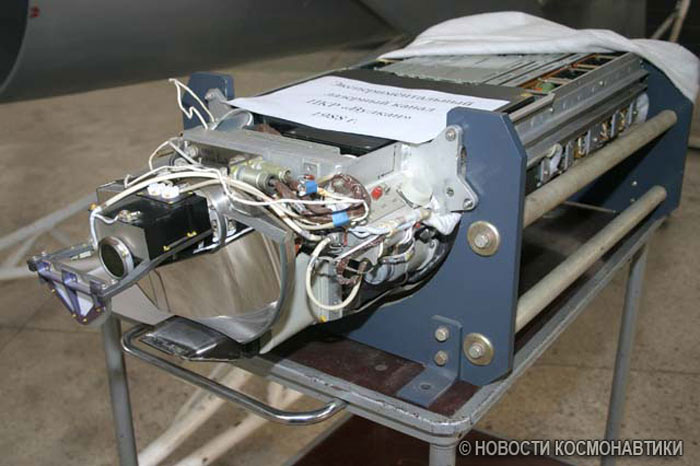
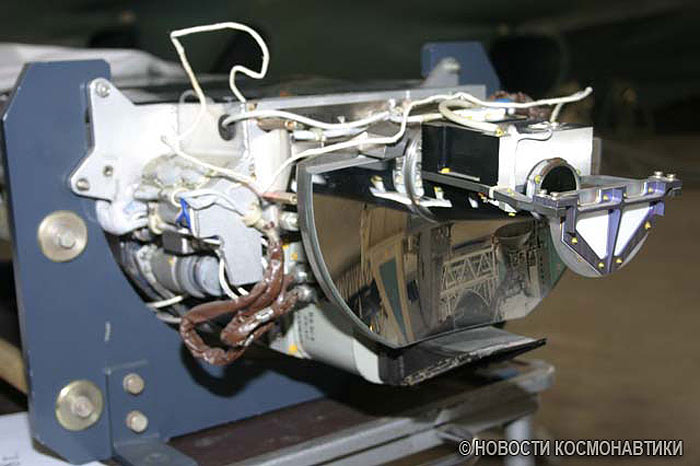
Pilot laser channel control rocket complex P-1000 "Volcano", 1988 (photo - showroom NGO "Engineering", Reutov, 15.08.2006,http://www.novosti-kosmonavtiki.ru )
Within the framework of the ROC "Volcano" was conducted research "Radiation" in which task was to analyze the impact of damaging factors of nuclear explosion (SAMs) on attackers RCC. In the course of research it conducted a real nuclear explosion in a specially equipped tunnel on Novaya Zemlya. Tests have shown that most of the elements onboard control systems of missiles were amazed neutron radiation at a distance of mechanical damage from a nuclear explosion. Some of the chips gained irreversible changes over long distances, causing a need for their further development for use in airborne systems, missile complex "Volcano."
The missile 3M70: Construction - used in the construction of new materials - including titanium alloys. The armor protection reduced.

Model 3M70 missile complex "Volcano" with increased CDS Air Show MAKS-2009 (photo - A.V.Karpenko, http://bastion-karpenko.narod.ru/ ).
Engines :
- front-booster stage - SRM with controlled nozzles, more powerful than that of U-500 . It can be used with the starting solid propellant missiles P-500 "Basalt". There is a possibility that the published photos of the original SRM "Vulcan" yet.
Hours Homepage-booster stage - 12 - marching - korotkoresursny TRD KR-17B, a similar rocket engine complex P-500 . Designed OKB-300 GKAT.
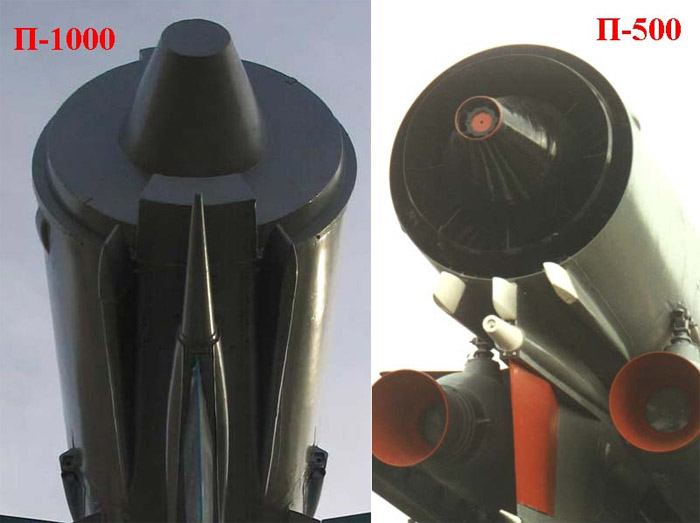
The tail of the missile complexes P-1000 and P-500 with the nozzles of the main engines and antennas (file photo Skeptical 2,http://forums.airbase.ru ). The missile complex "Volcano" with increased native CDS model, the exhibition MAKS -2009 (http://maks.sukhoi.ru )
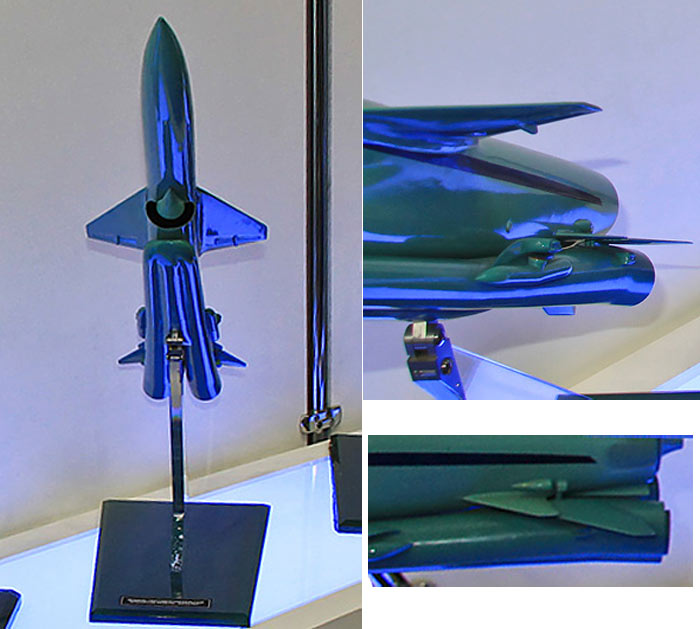
TTX missiles :
length - 11.7 m
Case Diameter - 0.88 m
Wingspan - 2.6 m Weight starting - 9300 kg (?) Weight without starting the engine - 5070 kg (4800 kg dr.dannym) Range - 550-700 km (depending the profile of the flight), some sources indicate 1000 km speed - 2 / 2.5 M (at low altitude / high altitude) Altitude - minimum - 15-20 m
warhead types : - explosive-cumulative; armor-piercing warhead test launches were made on the ground stand ("rocket path").According to the calculations required for the destruction of an aircraft carrier hit 3 missiles. The mass of explosives - 500 kg Armor penetration - up to 400 mm - the nuclear capacity of 350 kt
Modifications :
- P-1000 "Volcano" - anti-ship missile. - "Volcano LK" - modification of the missile complex "Volcano" with laser guidance channel ( see. "The control system and guidance," above )
Media : - missile cruiser pr.1164 " Varyag "(put into operation October 16, 1989 under the name" Red Ukraine ") was originally armed with complex P-1000. Also likely by 2006 at the RK "Moscow" complex P-1000 is installed, instead of U-500 in the course of modernization. Also planned for installation on an unfinished missile cruiser "Ukraine" (former "Admiral Lobov" is on the GCC in Nikolaev). The ship set PU 16 non-rechargeable (charge is carried out in the port).

The rocket complex P-1000 "Volcano" with the missile cruiser "Varyag" pr.1164 probably 1994 (file photo Skeptical 2,http://forums.airbase.ru ) missile cruiser "Moskva" pr.1164, the beginning of the 2000s ( http://militaryphotos.net ) Loading of ammunition on the missile cruiser "Moskva" pr.1164, Sevastopol, August 14, 2004 (photo - USSRNAVY, http://forums.airbase.ru ) loading missiles 3M70 complex P-1000 "volcano" on the missile cruiser "Moskva", the Black Sea Fleet, 2006 (photo - Dmitry Stogniy,http://militaryphotos.net )
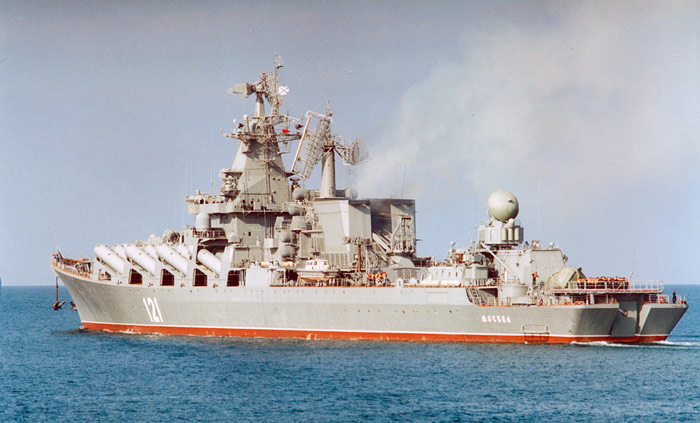
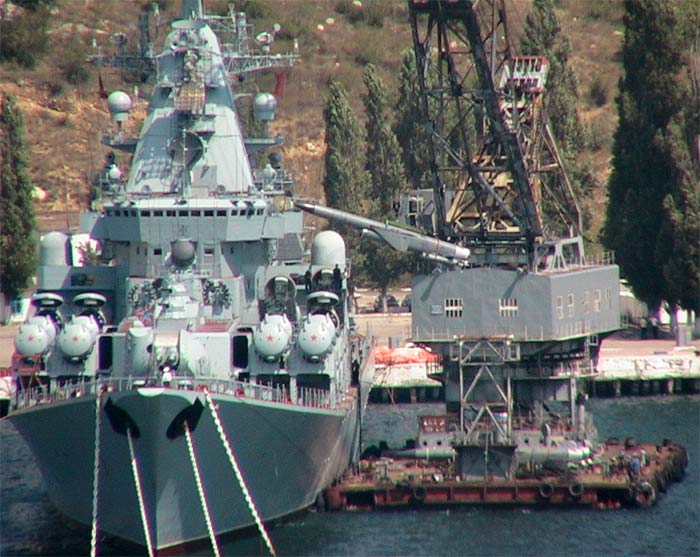
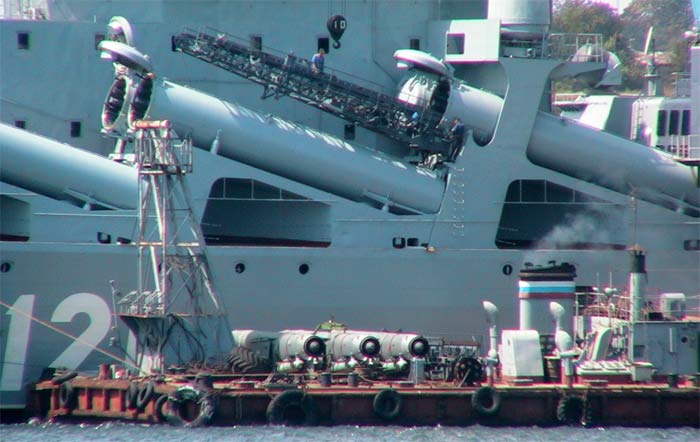
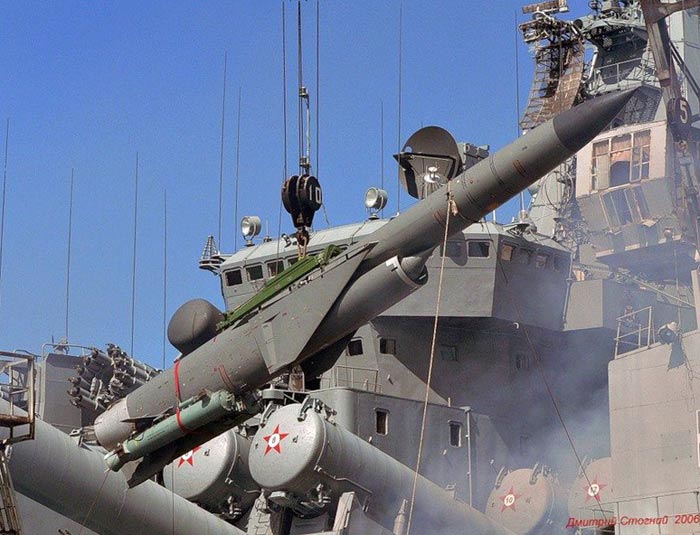
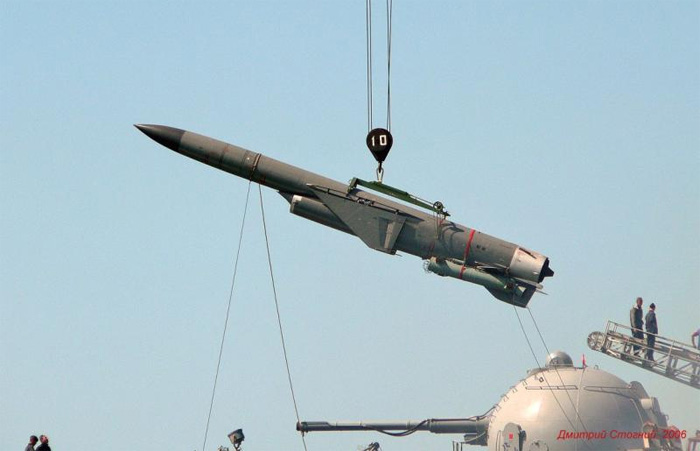
- SSGN pr.675MKV - conversion of 5 SSGN pr.675MK (K-1, K-22, K-34, K-35 and K-10) was conducted by pr.675MKV SRH "Star".Conversion SSGN K-1 launched December 15, 1981 and was completed in 1983. The modernization SSGN K-10 is not completed, all converted SSGN 4. On SSGN launchers complex P-500 replaced starting complex "Volcano" (8 pcs on submarines). Launchers starting from surface. Fire control system on submarines - "Argon-675MKV." For targeting satellite data used by the system "Killer Whale". SSGN withdrawn from the Navy from July 1992 to July 1994 (all 4 pieces).

Tentative projections missile complex P-1000 "Volcano" (Allocer, http://ru.wikipedia.org )
Status - the Soviet Union and Russia
- 2003 May 16 - the missile cruiser "Moskva" pr.1164 made training missile launches complex P-1000 "volcano" in the north-eastern part of the Arabian Sea. - 22 January 2008 - the Black Sea Fleet missile cruiser Russia "Moscow" pr.1164 within the active phase of joint military exercises naval strike group Northern and Russian Black Sea Fleet in the Atlantic has applied a unique anti-ship missile complex "Basalt" RCC "Vulcan" for firing at sea targets successfully hit the target ( source ).
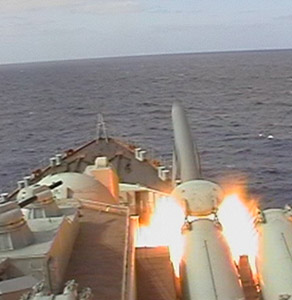
The rocket "Volcano" means complex "Basalt" cruiser "Moskva" pr.1164, Mediterranean Sea, 22.01.2008, the ( source ).
- 2010 - is in service for at least 2 missile cruisers pr.1164 - "Moscow" and "Varyag".
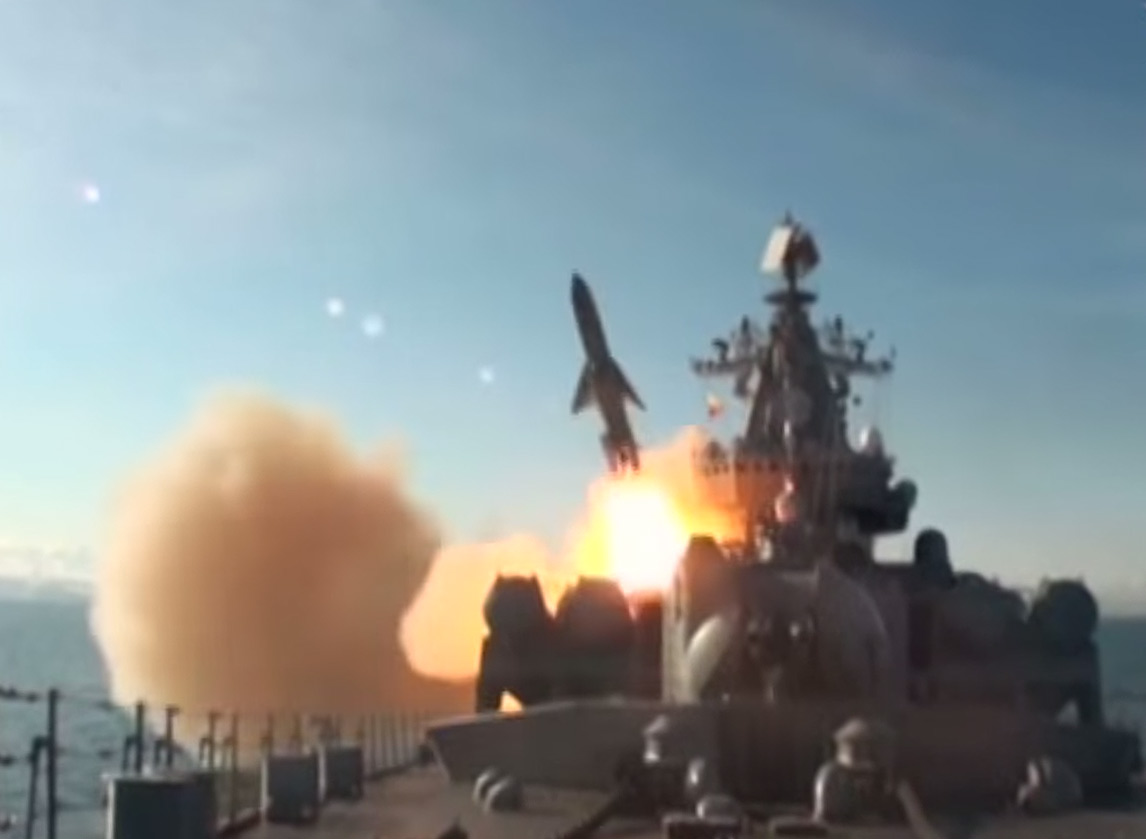
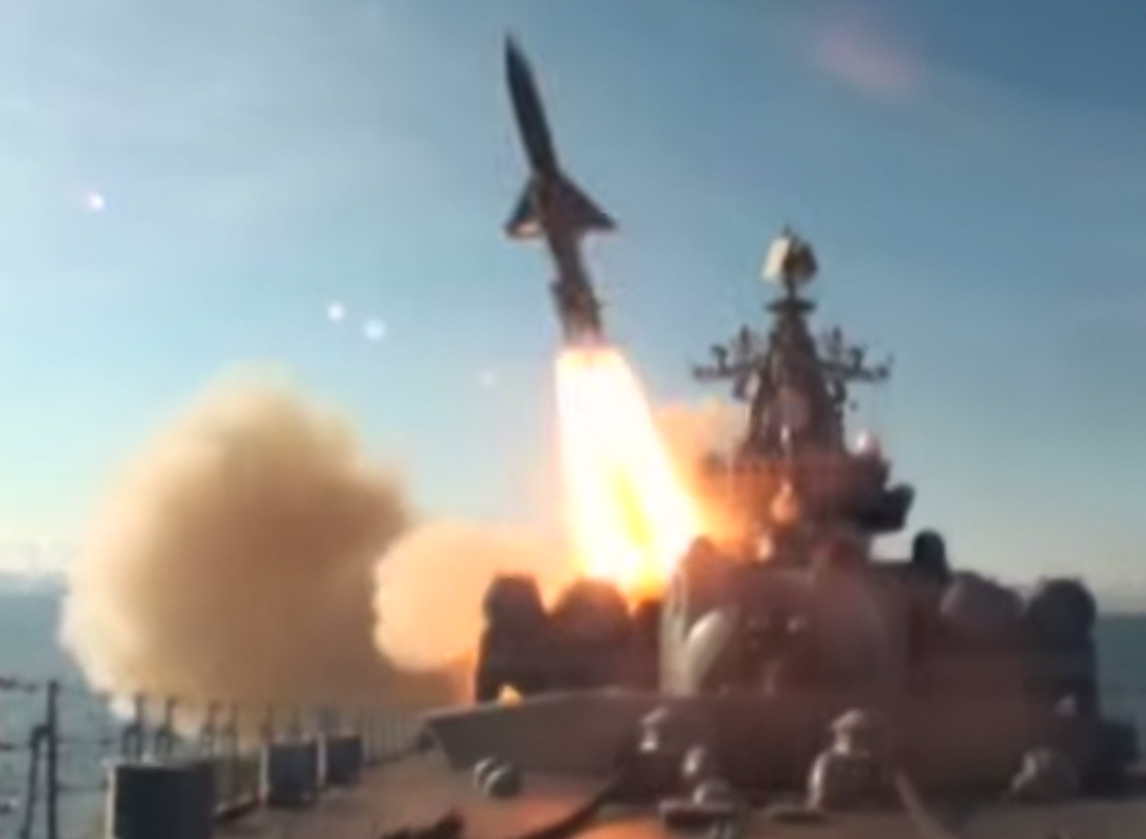
The rocket P-1000 "Volcano" with the missile cruiser "Varyag" during exercises "Vostok-2014", September 2014 (the frame channel "Star", source ).
Sources :
Wikipedia - Encyclopedia of freedom. Site http://ru.wikipedia.org , 2010
Zhabsky A. Volcano delivery. // St. Petersburg Gazette. №022 from 07.02.2008
Lazarev NM Oceanic nuclear missile fleet of the Soviet Union in his biographies of artists, creators and naval ship mechanical engineers.t. III, M., 2003
These supersonic. Site http://www.testpilot.ru , 2010
Osinin SN, EW Navy. From Port Arthur to the present day. M., "Arms and Technologies", 2006
Creators and founders. Ode team. M., NGOs Engineering 2009
AV Chizhov, "80 years of the Central Research Institute" Granit "(Chronicle of the tests)." S.-Pb., Central Research Institute "Granit" , 2001 .
Shirokorad AB, fiery sword of the Russian Navy. M., "Yauza", "Penguin Books" 2004
Balancer.ru. Site http://forums.airbase.ru , 2010
The first test-fired from the ground stand SM-49 Nenoksa - December 3, 1982 ( 10 hours 55 minutes) - start failure - starting block is not separated from the rocket, the rocket broke apart and fell by 8 flight. The second launch - April 9, 1983 - the same result by 9 seconds of flight. As a result of analysis of failed tests found that the failures were the fault of the control system of the rocket. The third start was successful (probably in June 1983). Tests with SSGN pr.675MKV launched December 22, 1983 Joint testing of the complex P-1000 and SSGN pr.675MKV - 1985, the first launch in joint trials - 2 missile salvo (two missiles hit the target in spite of the failure of the system maintain the pressure in the instrument compartment and operator error).
The second launch through joint tests - November 8, 1985 - trehraketny volley, one rocket was the failure of the radar sighting device (radar), two other rockets poryazili goal. As a result, aircraft design, and joint tests performed 18 launches of which 11 are found to be successful launches. Test management and test equipment completed in 1985. In December 1985 signed the act of completion of joint testing with the recommendation of the complex P-1000 "Vulcan" to the adoption with carrying out routine tests in 1986 to carry out routine tests allocated 8 rockets planned to spend 4 missile salvo and 4 single missile launch different programs.
One of the single starts (24 April 1986) was held with the starting rocket engine complex of P-500 on the program management of the complex missile P-500. Start was successful. 18 and 19 June 1986 held two successful start-up to check noise immunity missiles.Chetyrehraketny volley was held July 4, 1986 (three missiles equipped with telemetry equipment on the grounds that the equipment at the site could not receive information from 4 missiles). The rocket is not equipped with a telemetry system, lost control on the approach to the target, the cause has not been established. In 1986, the creators of the complex have been awarded the Prize of the USSR Lenenskoy (source ). Complex "Volcano" adopted by 18 December 1987 Series production of missiles complex "Volcano" was conducted on the "Arrow" in Orenburg. Rocket made from 1985 to 1992

3M70 missile complex P-1000 "Volcano" ( http://www.cruiser-moskva.info ).

Start 3M70 missile complex P-1000 "Volcano" with conventional CDS ( http://www.npomash.ru ).
Launcher :
- ground launcher SM-49 - test missiles at the site Nenoksa;
- missile cruiser pr.1164 - probably Single container PU CM-248, similar complexes U-500
- SSGN pr.675MKV - probably similar to PU Single container complex P-500


Start 3M70 missile complex P-1000 "Volcano" with pr.1164 missile cruiser "Moskva" ( http://www.npomash.ru , http://forums.airbase.ru ).
Control and guidance - inertial missile control with correction according to the radar homing - developed by the Central Research Institute "Granit", chief designer of the control system A.V.Chizhov, on-board radio-technical equipment - B.L.Godlinik, autopilot - AN Kuchin, FDC - V.A.Nikoltsev and E.A.Gorbachev. Breeding goals probably either automatically or by remote control principle (the operator of the ship according to radar missiles), or a combination. The rocket used made on the basis of a new element to the onboard computer autopilot A21 B9 (other than the missiles of F-500), which is coupled with a new starter motor and other (probably) control algorithm for the starting phase of the trajectory, which increased range. Significantly improved noise immunity radar seeker by improving on-board digital computer.
Ship and aircraft (placed on the rocket) appliances automated control system, as well as test equipment and control complex re-created. The control system launch, depending on the configuration starting the engine can be operated according to the program start-up and flight ASM P-500 "Basalt" or program " Volcano. " The missile guidance algorithms used by logic select the main goal in the order ships. After receiving the coordinates of the target, a missile with radar switched off (radio-locating visor) decreased by low altitude and to fly to the point of target coordinates. At the point of origin objectives include radar (radio-location finder), and selects and target acquisition. Analyze the size of the goals and objectives of the removal of the point target coordinates. Lift excess agloritm allows you to choose the biggest target in the order ships.
In order to overcome missile defense and air defense rocket provided protivozenitny maneuvering at low altitude and the dispersal of missiles in a salvo at the front (to be preceded by a gathering with a group of rockets) before turning on the radar at the final stage. The rocket is set Station setting jamming protection system 4B-89 "Bumblebee", developed since 1965 in the laboratory of the department №25 CRI "Granite" under the guidance and R.T.Tkacheva Yu.A.Romanova.
Instrument compartment on a rocket made airtight and equipped with sitemy maintain pressure (test starts for the shore stand in Nenoksa since March 25, 1984 Decree of the USSR in October 1987 instructed to carry out work to improve the accuracy of missiles of "Volcano" with working precision laser guidance channel and the creation of missiles "Volcano LK" . Work on the pulsed laser guidance channel conducted CRI "Granite" under the leadership of S.A.Sharova. system to recognize the geometric parameters of the target ship, and provide instructions on the correct trajectory of a missile to hit the most vulnerable sections of the target ship. System Tests were conducted in Sevastopol for passing ships and aircraft flying laboratory IL-18.
Development of laser guidance channel as a missile guidance systems started up in 1987 chief designer of onboard equipment missiles - V.G.Senkov, chief designer of the laser channel - S.N.Sharov. The launches of missiles equipped with homing serial laser channel planned for 1987-1989 gg Channel laser equipment was placed in the diffuser inlet. Technological missile for ground tests of the system has passed bench tests. On the test site in North Nenoksa it planned to make 5 missile launches from the ground stand (on dr.dannym test allocated 9 missiles). But probably in 1988-1989, the development of the theme of "Volcano LC" was discontinued. The beam diameter - ok.10 m Recognition range - 12-15 km


Pilot laser channel control rocket complex P-1000 "Volcano", 1988 (photo - showroom NGO "Engineering", Reutov, 15.08.2006,http://www.novosti-kosmonavtiki.ru )
Within the framework of the ROC "Volcano" was conducted research "Radiation" in which task was to analyze the impact of damaging factors of nuclear explosion (SAMs) on attackers RCC. In the course of research it conducted a real nuclear explosion in a specially equipped tunnel on Novaya Zemlya. Tests have shown that most of the elements onboard control systems of missiles were amazed neutron radiation at a distance of mechanical damage from a nuclear explosion. Some of the chips gained irreversible changes over long distances, causing a need for their further development for use in airborne systems, missile complex "Volcano."
The missile 3M70: Construction - used in the construction of new materials - including titanium alloys. The armor protection reduced.

Model 3M70 missile complex "Volcano" with increased CDS Air Show MAKS-2009 (photo - A.V.Karpenko, http://bastion-karpenko.narod.ru/ ).
Engines :
- front-booster stage - SRM with controlled nozzles, more powerful than that of U-500 . It can be used with the starting solid propellant missiles P-500 "Basalt". There is a possibility that the published photos of the original SRM "Vulcan" yet.
Hours Homepage-booster stage - 12 - marching - korotkoresursny TRD KR-17B, a similar rocket engine complex P-500 . Designed OKB-300 GKAT.

The tail of the missile complexes P-1000 and P-500 with the nozzles of the main engines and antennas (file photo Skeptical 2,http://forums.airbase.ru ). The missile complex "Volcano" with increased native CDS model, the exhibition MAKS -2009 (http://maks.sukhoi.ru )

TTX missiles :
length - 11.7 m
Case Diameter - 0.88 m
Wingspan - 2.6 m Weight starting - 9300 kg (?) Weight without starting the engine - 5070 kg (4800 kg dr.dannym) Range - 550-700 km (depending the profile of the flight), some sources indicate 1000 km speed - 2 / 2.5 M (at low altitude / high altitude) Altitude - minimum - 15-20 m
warhead types : - explosive-cumulative; armor-piercing warhead test launches were made on the ground stand ("rocket path").According to the calculations required for the destruction of an aircraft carrier hit 3 missiles. The mass of explosives - 500 kg Armor penetration - up to 400 mm - the nuclear capacity of 350 kt
Modifications :
- P-1000 "Volcano" - anti-ship missile. - "Volcano LK" - modification of the missile complex "Volcano" with laser guidance channel ( see. "The control system and guidance," above )
Media : - missile cruiser pr.1164 " Varyag "(put into operation October 16, 1989 under the name" Red Ukraine ") was originally armed with complex P-1000. Also likely by 2006 at the RK "Moscow" complex P-1000 is installed, instead of U-500 in the course of modernization. Also planned for installation on an unfinished missile cruiser "Ukraine" (former "Admiral Lobov" is on the GCC in Nikolaev). The ship set PU 16 non-rechargeable (charge is carried out in the port).

The rocket complex P-1000 "Volcano" with the missile cruiser "Varyag" pr.1164 probably 1994 (file photo Skeptical 2,http://forums.airbase.ru ) missile cruiser "Moskva" pr.1164, the beginning of the 2000s ( http://militaryphotos.net ) Loading of ammunition on the missile cruiser "Moskva" pr.1164, Sevastopol, August 14, 2004 (photo - USSRNAVY, http://forums.airbase.ru ) loading missiles 3M70 complex P-1000 "volcano" on the missile cruiser "Moskva", the Black Sea Fleet, 2006 (photo - Dmitry Stogniy,http://militaryphotos.net )





- SSGN pr.675MKV - conversion of 5 SSGN pr.675MK (K-1, K-22, K-34, K-35 and K-10) was conducted by pr.675MKV SRH "Star".Conversion SSGN K-1 launched December 15, 1981 and was completed in 1983. The modernization SSGN K-10 is not completed, all converted SSGN 4. On SSGN launchers complex P-500 replaced starting complex "Volcano" (8 pcs on submarines). Launchers starting from surface. Fire control system on submarines - "Argon-675MKV." For targeting satellite data used by the system "Killer Whale". SSGN withdrawn from the Navy from July 1992 to July 1994 (all 4 pieces).

Tentative projections missile complex P-1000 "Volcano" (Allocer, http://ru.wikipedia.org )
Status - the Soviet Union and Russia
- 2003 May 16 - the missile cruiser "Moskva" pr.1164 made training missile launches complex P-1000 "volcano" in the north-eastern part of the Arabian Sea. - 22 January 2008 - the Black Sea Fleet missile cruiser Russia "Moscow" pr.1164 within the active phase of joint military exercises naval strike group Northern and Russian Black Sea Fleet in the Atlantic has applied a unique anti-ship missile complex "Basalt" RCC "Vulcan" for firing at sea targets successfully hit the target ( source ).

The rocket "Volcano" means complex "Basalt" cruiser "Moskva" pr.1164, Mediterranean Sea, 22.01.2008, the ( source ).
- 2010 - is in service for at least 2 missile cruisers pr.1164 - "Moscow" and "Varyag".


The rocket P-1000 "Volcano" with the missile cruiser "Varyag" during exercises "Vostok-2014", September 2014 (the frame channel "Star", source ).
Sources :
Wikipedia - Encyclopedia of freedom. Site http://ru.wikipedia.org , 2010
Zhabsky A. Volcano delivery. // St. Petersburg Gazette. №022 from 07.02.2008
Lazarev NM Oceanic nuclear missile fleet of the Soviet Union in his biographies of artists, creators and naval ship mechanical engineers.t. III, M., 2003
These supersonic. Site http://www.testpilot.ru , 2010
Osinin SN, EW Navy. From Port Arthur to the present day. M., "Arms and Technologies", 2006
Creators and founders. Ode team. M., NGOs Engineering 2009
AV Chizhov, "80 years of the Central Research Institute" Granit "(Chronicle of the tests)." S.-Pb., Central Research Institute "Granit" , 2001 .
Shirokorad AB, fiery sword of the Russian Navy. M., "Yauza", "Penguin Books" 2004
Balancer.ru. Site http://forums.airbase.ru , 2010




